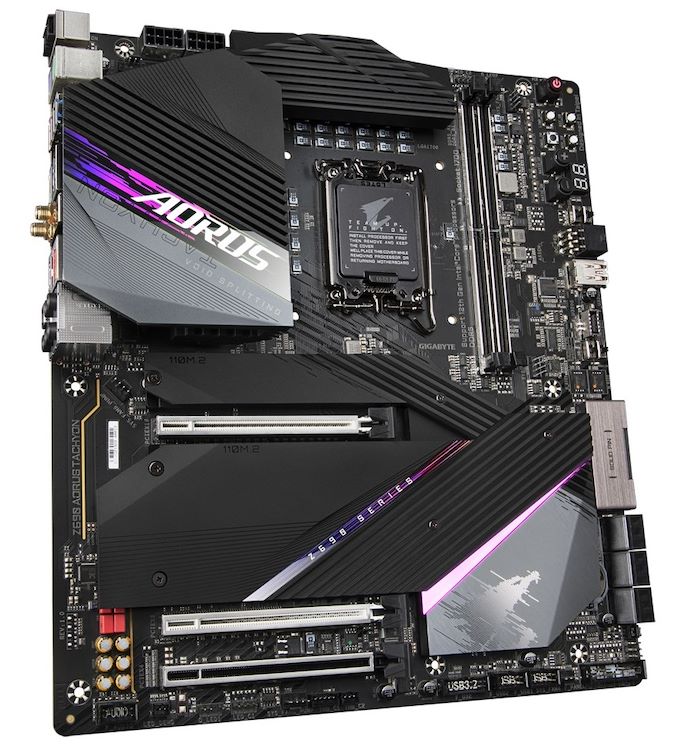The Intel Z690 Motherboard Overview (DDR5): Over 50+ New Models
by Gavin Bonshor on November 9, 2021 9:00 AM ESTGIGABYTE Z690 Aorus Tachyon (DDR5)
One of GIGABYTE's more recent additions to its Aorus series of motherboards is the Tachyon. Initially debuted on the previous Z590 chipset, we did review the GIGABYTE Z590 Aorus Tachyon earlier in the year and we found it to be one of the best clocking Z590 boards we tested. As it's primarily aimed at sub-ambient overclockers, many won't appreciate the 'extreme' features enabled on this model. The design of the latest Z690 Aorus Tachyon is similar to the previous version in many ways, including a large finned rear panel cover with integrated RGB LEDs, with more around the chipset heatsink. In the top right-hand corner of the board is a comprehensive overclocker's toolkit which includes many switches including a cold reset button, CPU ratio up and down buttons, as well as a set of voltage measurement points.
GIGABYTE is advertising the Z690 Tachyon to feature a direct 18-phase power delivery operating at 15+1+2, with dual 8-pin CPU power inputs providing juice to the CPU.
Looking at the core feature set of the GIGABYTE Z690 Aorus Tachyon, there's a pair of memory slots to the right of the LGA1700 socket with support for DDR5-7000 which is the fastest supported speed of any board we have seen at launch so far. Both memory slots can accommodate a maximum of 64 GB. For PCIe expansion, GIGABYTE includes two full-length PCIe 5.0 slots that can operate at x16 or x8/x8, with a third full-length slot electronically locked down to PCIe 3.0 x4. Focusing on storage, there's are three PCIe 4.0 x4 M.2 slots, as well as six SATA ports that are capable of supporting RAID 0, 1, 5, and 10 arrays.
On the rear panel is one USB 3.2 G2x2 Type-C, three USB 3.2 G2 Type-A, and four USB 3.2 G1 Type-A ports. A Realtek ALC1220VB HD audio codec powers five 3.5 mm audio jacks and S/PDIF optical output, while GIGABYTE also includes separate PS/2 keyboard and mice inputs. For networking, there's one Intel I225-V 2.5 GbE controller, with an Intel AX210 Wi-Fi 6E CNVi providing both wireless and BT 5.2 connectivity. Finishing off the rear panel is an HDMI 2.1 video output, an OC Ignition button, and a Q-Flash BIOS Flashback button.












126 Comments
View All Comments
Dahak - Tuesday, November 9, 2021 - link
Will there be a list of DDR4 only board as well?Ryan Smith - Wednesday, November 10, 2021 - link
Yes, we're also putting together a guide for DDR4 boards.jh20001 - Wednesday, December 1, 2021 - link
Any news on the DDR4 story? Would be nice to know what model is the best for performance/features in the eyes of others.Flunk - Tuesday, November 9, 2021 - link
Intel's actually released a compelling new chipset? I'm surprised to see DDR5 and PCIe 5 support, but USB 4 seems to be notably absent, despite there being no reason at all to omit it. Intel is finally one-upping AMD after a few years of playing #2.Exotica - Tuesday, November 9, 2021 - link
Thunderbolt4 is usb4 capable…CharonPDX - Tuesday, November 9, 2021 - link
Yep, the only thing USB4 adds over "USB 3.2 2x2" is Thunderbolt support. Therefore any Thunderbolt 4 device is automatically USB4. In fact, essentially any board with "Thunderbolt 3" along with USB 3.2 2x2 basically get "USB4" status for free.DigitalFreak - Tuesday, November 9, 2021 - link
USB 3.2 2x2 is 20 Gbps. USB 4 is 40 Gbps.12345 - Wednesday, November 10, 2021 - link
That's why they mentioned TB3. 40Gbps support is also optional for USB4.12345 - Wednesday, November 10, 2021 - link
DP 2.0 is mandatory for USB4 so TB3 support isn't good enough.KarlKastor - Wednesday, November 10, 2021 - link
That is only the name. The question is, with what speed you can run USB devices.